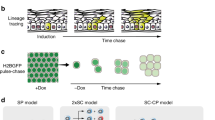Summary
Thirty-five years ago Honor Fell and Edward Mellanby were studying effects of high doses of vitamin A on skeletal development in chick embryos when they noticed that a piece of epidermis, accidentally included in an organ culture, had undergone mucous metaplasia. Further studies by Fell and others eventually led to an understanding of the important role of vitamin A in modulating epithelia in vivo. Fifteen years later another organ culture experiment showed me that excess vitamin A could also initiate the morphogenesis of branching and mucus-secreting glands from developing vibrissa follicles in upper lip skin of embryonic mice. Since then our group has shown that induction of this novel structure by naturally occurring retinoids resembles a normal embryonic induction in that it is stage-dependent, time-dependent, and irreversible. Tissue separation and recombination studies showed that isolated upper lip epidermis can form these glands when combined with retinoid-treated upper lip dermis. Untreated mouse epidermis can form similar glands after combination with chick dermis containing higher retinoid levels. The hamster cheek pouch, normally devoid of glandular structures, can also form mucous glands when treated with a retinoid, either in vivo or in vitro. Recombination studies in organ culture have now shown that mesenchyme exposed to retinoid is essential for gland morphogenesis from pouch epithelium. Evidences is accumulating that retinoic acid may even be the active morphogen in some normally developing systems.
Similar content being viewed by others
References
Cadi, R.; Dhouailly, D.; Sengel, P. Use of retinoic acid for the analysis of dermal-epidermal interactions in the tarsometatarsal skin of the chick embryo. Dev. Biol. 100:480–495; 1983.
Covant, H. A. An investigation of the site of retinoid action in the induction of glands from the hamster cheek pouch. Guelph, Canada: Univ. Guelph; 1987. Thesis.
Covant, H. A.; Hardy, M. H. Stability of the glandular morphogenesis produced by retinoids in the newborns hamster cheek pouch in vitro. J. Exp. Zool. 246:139–149; 1988.
Dhouailly, D. Dermis-epidermal interactions during morphogenesis of cutaneous appendages in mammals. Front. Matrix Biol. 4:86–121; 1977.
Dhouailly, D.; Hardy, M. H. Retinoic acid causes the development of feathers in the scale-forming integument of the chick embryo. Wilhelm Roux's Arch. Dev. Biol. 185:195–200; 1978.
Dhouailly, D.; Hardy, M. H.; Sengel, P. Formation of feathers on chick foot scales: a stage-dependent morphogenetic response to retinoic acid. J. Embryol. Exp. Morphol. 58:63–78; 1980.
Dhuailly, D.; Hardy, M. H.; Vahlquist, A. Glandular morphogenesis of mouse epidermis associated with chick dermis is enhanced by retinoic acid treatment. Dermatologica 169:228–229; 1984.
Fell, H. B. The effect of excess vitamin A on cultures of embryonic chicken skin explanted at different stages of differentiation. Proc. R. Soc. Lond. B. Biol. Sci. 146:242–256; 1957.
Fell, H. B. Some effects of environment on epidermal differentiation. Br. J. Dermatol. 74:1–5; 1962.
Fell, H. B.; Mellanby, E. The effect of hypervitaminosis A on embryonic limb bones cultivatedin vitro. J. Physiol. (Lond.) 116:320–349; 1952.
Fell, H. B.; Mellanby, E. Metaplasia produced in cultures of chick ectoderm by high vitamin A. J. Physiol. (Lond.) 119:470–488; 1953.
Fell, H. B.; Rinaldini, L. M. The effects of vitamins A and C on cells and tissues in culture. In: Willmer, E. N., ed. Cells and tissues in culture. Methods, biology and physiology, vol. 1. London: Academic Press; 1965:659–699.
Fitton Jackson, S.; Fell, H. B. Epidermal fine structure in embryonic chicken skin during atypical differentiation induced by vitamin A in culture. Dev. Biol. 7:394–419; 1963.
Giguere, V.; Ong, E. S.; Segui, P., et al. Identification of a receptor for the morphogen retinoic acid. Nature 330:624–629; 1987.
Goldberg, E. A.; Hardy, M. H. Heterotypic cell contacts and basal lamina morphology during hair follicle development in the mouse. Can. J. Zool. 61:2703–2719; 1983.
Hardy, M. H. The development of mouser hairin vitro with some observations on pigmentation. J. Anat. 83:364–384; 1949.
Hardy, M. H. Glandular metaplasia of hair follicles and other responses to vitamin A excess in cultures of rodent skin. J. Embryol. Exp. Morphol. 19:157–180; 1968.
Hardy, M. H. The differentiation of hair folliciles and hairs in organ culture. Adv. Biol. Skin 9:35–60; 1969.
Hardy, M. H. Vitamin A and the epithelial-mesenchymal interactions in skin differentiation. In: Sawyer, R. H.; Fallon, J. F., eds. Epithelial-mesenchymal interactions in development. New York: Praeger; 1983:163–188.
Hardy, M. H.; Bellows, C. G. The stability of vitamin A-induced metaplasia of mouse vibrissa follicles in vitro. J. Invest. Dermatol. 71:236–241; 1978.
Hardy, M. H.; Van Exan, R. J.; Sonstegarg, K. S., et al. Basal lamina changes during tissue interactions in hair follicles—an in vitro study of normal dermal papillae and vitamin A-induced glandular morphogenesis. J. Invest. Dermatol. 80:27–34; 1983.
Lawrence, D. J.; Bern, H. A. Mucous metaplasia and mucous gland formation in keratinized adult epitheliumin situ treated with vitamin A. Exp. Cell Res. 21:443–446; 1960.
Mock, D.; Main, J. H. P. The effect of vitamin A on hamster cheek pouch mucosa in organ culture. J. Dent. Res. 58:635–637; 1978.
Petkovich, M.; Brand, N. J.; Krust, A., et al. A human retinoic acid receptor which belongs to the family of nuclear receptors. Nature 330:444–450; 1987.
Summerbell, D. The effect of local applications of rationic acid to the anterior margin of the developing chick limb. J. Embryol. Exp. Morphol. 78:269–289; 1983.
Thaller, C.; Eichele, G. Identification and spatial distribution of retinoids in the developing chick limb bud. Nature 327:625–628; 1987.
Trifiates, G. P.; Prasad, K. N., eds. Nutrition, growth and cancer. Progress in clinical and biological research 259. New York: Alan R. Liss; 1988.
Van Exan, R. J. An in vitro study of the effects of excess vitamin A on the differentiation of the mammalian dermis. Guelph, Ontario: Univ. Guelph; 1979. Thesis.
Author information
Authors and Affiliations
Rights and permissions
About this article
Cite this article
Hardy, M.H. The use of retinoids as probes for analyzing morphogenesis of glands from epithelial tissues. In Vitro Cell Dev Biol 25, 454–459 (1989). https://doi.org/10.1007/BF02624632
Received:
Accepted:
Issue Date:
DOI: https://doi.org/10.1007/BF02624632




